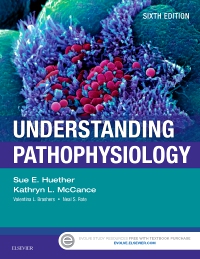
Understanding Pathophysiology - Elsevier eBook on VitalSource, 6th Edition
Elsevier eBook on VitalSource

Now $118.74
Master the important pathophysiology concepts you need to know with the most engaging and reader-friendly text available. Filled with vibrant illustrations and complemented by online resources that bring pathophysiology concepts to life, Understanding Pathophysiology, 6th Edition continues its tradition of delivering the most accurate information on treatments, manifestations, and mechanisms of disease across the lifespan, giving you the fundamental knowledge needed to move forward in your nursing education and career. New additions include a new chapter on epigenetics, new content on rare diseases, a separate chapter for male and female reproductive alterations, streamlined features, simplified language, and fully updated information throughout.
Newer Edition Available
Understanding Pathophysiology - Elsevier eBook on VitalSource
-
- Introduction to Pathophysiology in the front matter section provides intro to the subject of pathophysiology and explains why it is important.
- Consistent presentation helps readers better distinguish pathophysiology, clinical manifestations, and evaluation and treatment for each disease.
- More than 1,000 high-quality illustrations vividly depict clinical manifestations and cellular mechanisms underlying diseases.
- Lifespan coverage details age-specific conditions affecting pediatric, adult, and aging patients in depth.
- Algorithms throughout the text clarify disease progression.
- Risk Factor boxes alert readers to important safety considerations associated with specific diseases.
- Health Alert boxes highlight new developments in biologic research, diagnostic studies, preventive care, treatments, and more.
- Quick Check boxes test readers’ retention of important chapter concepts.
- Geriatric Considerations boxes and Pediatric Considerations boxes highlight key considerations for these demographics in relevant chapters.
- Did You Understand? sections provide a fast and efficient review of chapter content.
- Chapter outlines help readers find specific information with ease.
- Chapter introductions explain why chapter content is important and how it fits into a broader health care context.
- Key terms are bolded throughout the text for fast, easy reference.
- Glossary of selected terms familiarizes readers with the most difficult or important terminology.
- Additional online resources on Evolve companion website offers access to animations, review questions, key terms matching exercises, and more.
-
- NEW! Chapter on Epigenetics gives students knowledge and insight into key processes that influence normal and abnormal cell growth and development.
- NEW! Streamlined tables and flowcharts make information easier to access.
- NEW! Updated content throughout reflects the latest clinical findings and research across the full spectrum of pathophysiology.
- NEW! Additional content on rare diseases gives students a more comprehensive understanding of conditions that affect the human body.
- NEW! Division of Alterations of the Reproductive Systems chapter will now cover male and female reproductive systems in separate chapters.
- NEW! 25 additional illustrations bring key concepts to life.
-
Frontmatter
Introduction to Pathophysiology
PART ONE: BASIC CONCEPTS OF PATHOPHYSIOLOGY
Unit 1: The Cell
1. Cellular Biology
2. Genes and Genetic Diseases
3. Epigenetics and Disease (NEW)
4. Altered Cellular and Tissue Biology
5. Fluids and Electrolytes, Acids and Bases
Unit 2: Mechanisms of Self-Defense
6. Innate Immunity: Inflammation and Wound Healing
7. Adaptive Immunity
8. Infection and Defects in Mechanisms of Defense
9. Stress and Disease
Unit 3: Cellular Proliferation: Cancer
10. Biology of Cancer
11. Cancer Epidemiology
12. Cancer in Children and Adolescents
PART TWO: BODY SYSTEMS AND DISEASES
Unit 4: The Neurologic System
13. Structure and Function of the Neurologic System
14. Pain, Temperature, Sleep, and Sensory Function
15. Alterations in Cognitive Systems, Cerebral Hemodynamics and Motor Function
16. Disorders of the Central and Peripheral Nervous Systems and Neuromuscular Junction
17. Alterations of Neurologic Function in Children
Unit 5: The Endocrine System
18. Mechanisms of Hormonal Regulation
19. Alterations of Hormonal Regulation
Unit 6: The Hematologic System
20. Structure and Function of the Hematologic System
21. Alterations in Hematologic Function
22. Alterations of Hematologic Function in Children
Unit 7: The Cardiovascular and Lymphatic Systems
23. Structure and Function of the Cardiovascular and Lymphatic Systems
24. Alterations of Cardiovascular Function
25. Alterations of Cardiovascular Function in Children
Unit 8: The Pulmonary System
26. Structure and Function of the Pulmonary System
27. Alterations of Pulmonary Function
28. Alterations of Pulmonary Function in Children
Unit 9: The Renal and Urologic Systems
29. Structure and Function of the Renal and Urologic Systems
30. Alterations of Renal and Urinary Tract Function
31. Alterations of Renal and Urinary Tract Function in Children
Unit 10: The Reproductive Systems
32. Structure and Function of the Reproductive Systems
33. Alterations of the Female Reproductive System
34. Alterations of the Male Reproductive System
Unit 11: The Digestive System
35. Structure and Function of the Digestive System
36. Alterations of Digestive Function
37. Alterations in Digestive Function in Children
Unit 12: The Musculoskeletal and Integumentary Systems
38. Structure and Function of the Musculoskeletal System
39. Alterations of Musculoskeletal Function
40. Alterations of Musculoskeletal Function in Children
41. Structure, Function, and Disorders of the Integument
42. Alterations of the Integument in Children
Glossary
Index
Appendix: Common Laboratory Values



